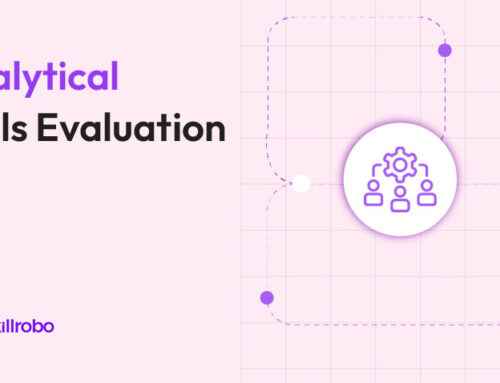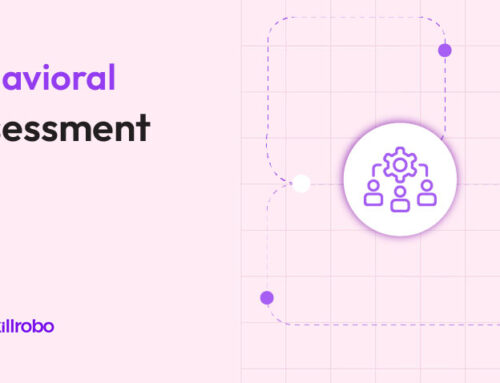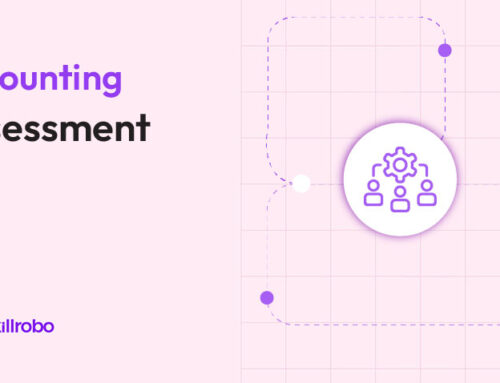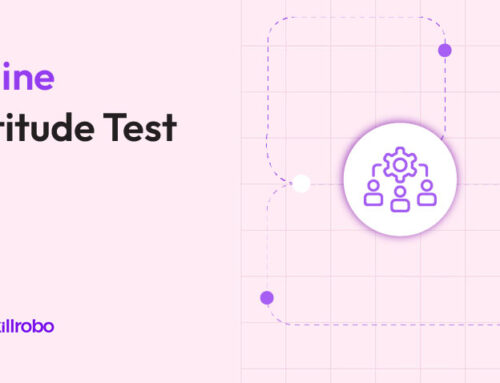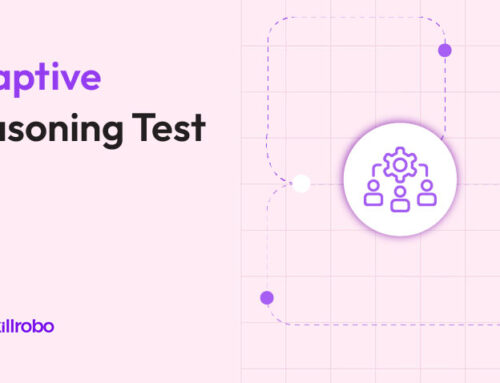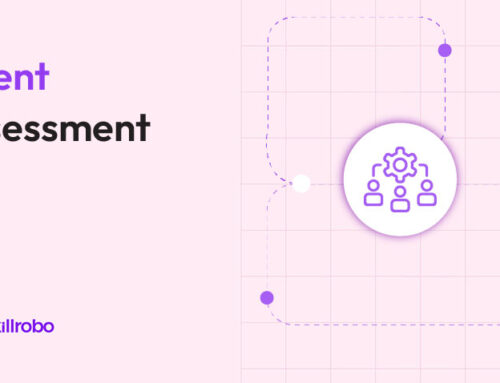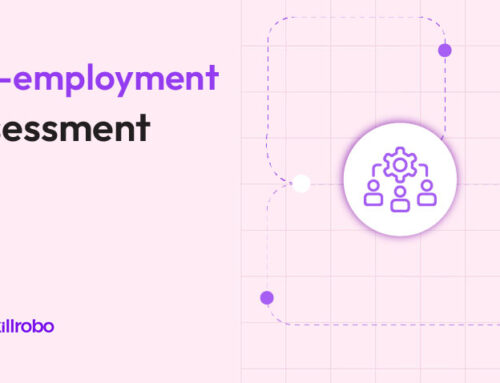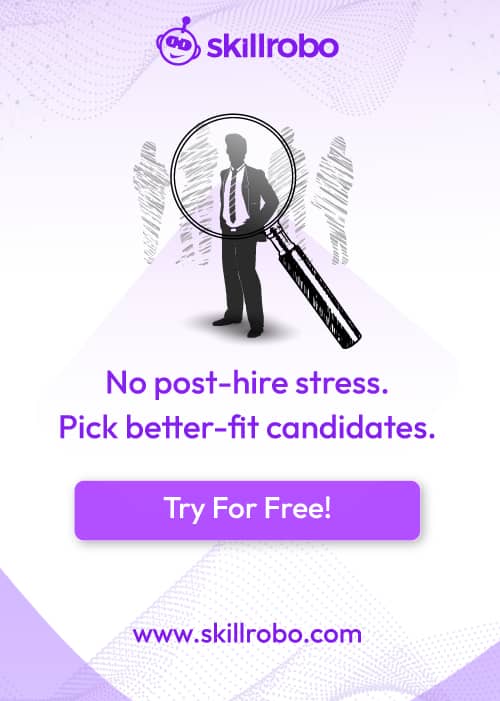Table of Contents
Related articles

A behavioral assessment test is a psychological instrument that analyzes, clarifies, and forecasts a candidate’s behavior. This assessment can be used at any stage of the employee professional development cycle. During the recruitment process, hiring managers will need to handle many potential candidates. Sifting through applicants to find the perfect hire who would significantly benefit the organization is a difficult experience. To avoid these conflicts, using behavioral assessment tools in your hiring process will benefit both the employer and the candidate.
Behavioral assessments are becoming increasingly significant in the workplace. Employing behavioral assessment tools will make it easier for recruiters to choose individuals who fit the position, organization, culture, etc. Every organization expects talents who are ready to exhibit their professional behavior and cognitive skills to build a strong team.
That can be achieved by evaluating the candidates through behavioral assessment tests during their hiring process. Not only for hiring a candidate, this tool helps while evaluating employees for performance appraisal. In this blog, you’ll know what a behavioral assessment tool is, its importance, types of assessment, and the top 8 best behavioral assessment tools in the market.
What Is A Behavioral Assessment Tool?
Behavioral assessment tools are software applications that evaluate and analyze a person’s behavior and personality attributes. Any phase of the employee life cycle, including recruitment, advancement, workforce development, team development, and leadership development, can use them. Employing assessment tools for behavioral problems will make it easier for recruiters to choose individuals who fit the position, organization, culture, etc.
As part of behavioral assessment tools, candidates are asked to exhibit particular behavioral abilities in one or more tasks modeled after real-world working scenarios. These tools are extensively used in the workplace for hiring and development because they blend creativity with scientific rigor to assess job and cultural fit. For a thorough investigation of individuals, many behavioral measurement tools can be utilized either individually or collectively.
A recruiter interacts with a lot of potential employees during the hiring process. Sorting through applicants to find the ideal hire who would significantly benefit the organization is a difficult experience. Employing behavior assessment tools will make it easier for recruiters to choose candidates who fit the position, organization, culture, etc.
Types Of Behavioral Assessment Tests
Candidates’ actions and personalities are two sides of the same coin. As a result, a variety of behavior types are assessed through candidate assessment tools. They can be broadly classified into 5 types:
1. Direct Assessment:
This is the evaluation of how behavior alters as a result of the circumstance. additionally referred to as “Situational Judgement Assessment.” This situational-based assessment provides test takers with a sequence of actual-life situations related to the position and company for which they are seeking.
SJTs are an excellent tool that can accommodate various tasks and circumstances and offer test-takers genuine scenarios that job-holders encounter regularly. Working in a team and resolving problems at work are two examples that may be mentioned. Based on how candidates do in a job simulation, they may anticipate how well they would perform on the job.
2. Analog Assessment:
This kind of behavioral assessment test is carried out to look at how behavior changes in hypothetical or simulated settings. Baseline observations are made to track the response frequencies that vary based on the circumstances. It contains a synopsis of the pertinent organizational dynamics and events. An organization, an industry, or a division of a company could all be parties in a case.
The candidate must evaluate the issues in the case, identify potential fixes, and recommend the best course of action. To help the candidate make business decisions based on the information, supporting fictional papers such as yearly reports, P&L statements, product research studies, etc. may be provided.
3. Indirect Assessment:
This type of assessment frequently includes parents, carers, teachers, and anybody else who is a part of the client’s surroundings. If the client can participate, it may even involve them, although this method obtains data on the desired behaviors without actually witnessing them. Parental interviews, either organized or unstructured, as well as rating tools like the Questions About Behavioral Function (QABF) or the Motivation Assessment Scale (MAS), are examples of indirect assessments.
4. Idiographic Assessment:
This type of assessment will evaluate the behavioral characteristics of the concerned individual.
5. Contextual Assessment:
In this type of assessment, the environmental factors that lead to a change in behavior are the main concern.
Why Do You Need Them?
The behavioral competencies of candidates are evaluated using behavioral measurement tools. By using these behavioral assessment tools, recruiters may streamline the hiring process and pick applicants who are a good fit for the position, organization, culture, etc.
Due to their ability to assess cultural fit by fusing innovation and scientific rigor, these techniques are employed in hiring and development. Behavior-measuring tools are accurate performance predictors that help in the selection and development processes inside organizations for the following reasons,
- Behavior analysis tools help in removing subjectivity and personal prejudice during the process.
- It assesses the candidate’s cultural fit and suitability for the organization.
- It helps with the use of simple filtration to cut down on hiring time.
- It helps in determining the training and intervention needs, and increasing retention rates.
Participants respond favorably to professional behavior assessment tools engaging and useful nature, which provide accurate job previews. Since there is no right or incorrect behavior, behavioral evaluation tools are a common strategy for employee development. Due to its relevance and exact replication of the work position, behavioral tools increase the likelihood that participants will accept the feedback they get.
These tools are made specifically for your company and are a terrific method to sell your employer’s brand and corporate culture. Additionally, by assisting you in selecting the best staff, they provide a high return on investment.
Big Five Model Of Behavioral Evaluation
Five attributes have been used by psychologists to categorize a person’s behavior or personality. They are also known as the “Five Factor model” and “OCEAN”. These five traits are
1. Openness:
The quality that makes people appreciate life and all that comes with it is an openness to new experiences. Studies show that applicants who are open to experience are more inquisitive, intelligent, and willing to try new things than applicants who are not.
2. Conscientiousness:
This personality trait demonstrates self-control and self-satisfaction. Candidates who exhibit this quality are seen as obstinate and goal-oriented.
3. Extraversion:
Extraversion shows a person’s level of vivacity, gregariousness, and friendliness. People can be classified as either extroverts or introverts. Extroverts prefer to interact with others regularly, whilst introverts do the reverse.
4. Agreeableness:
This characteristic displays the various social harmony-related worries. Agreeable people are soft and kind-hearted whereas disagreeable people are adamant and challenging to handle.
5. Neuroticism:
Neuroticism is the propensity to exhibit anger, tension, and other negative emotions. When compared to those with lower levels of neuroticism, those with high levels are typically more aggressive and less stable mentally.
Importance Of Behavioral Assessment In Candidate’s Pre-Assessment Tool
It takes a lot of effort and time to hire a candidate. A bad applicant equals a bad investment for the business. In addition to having the necessary education and technical skills, a candidate needs to have the proper attitude. The ideal candidate will be someone who can develop a positive working relationship with his coworkers and mold his character in the workplace.
To choose the best talent for the organization, a behavioral assessment helps to ascertain the personalities of the candidates. Every company aspires to build a core team of top performers who are committed to the community, self-driven, and forward-thinking in their attitudes and actions.
The thorough test report not only helps detect gaps but also aids in attracting the right people. This increases employee accountability and satisfaction with work.
Employers employ behavioral assessments for hiring because it is a reliable and efficient way to screen applicants, choose those who deserve the job, and streamline the hiring process. Organizations can solve the skill deficit and develop a highly qualified workforce by properly applying these assessments.
Similar to how job seekers might locate and work for employers who understand them. The test’s results serve as a basis for comparing people to gauge behaviors including adaptability, work ethic, teamwork, multitasking, compassion, leadership abilities, and openness to learning. Therefore, there are numerous advantages to behavioral assessment tests. They are an essential component of candidate assessment tools as a result.
How To Choose A Suitable Behavioral Assessment Tool?
Few things to consider when choosing a behavior assessment tool for your organization,
Reflection Of Job Role
By assessing the necessary behavioral competencies, select a set of behavioral assessment tools that reflect the job position. For an exhaustive evaluation, you might want to combine two or more tools. Make sure the behavioral tools are appropriate for the job level and the role. For instance, situational judgment assessments are excellent for individual contributors and mid-level or first-time managers, whereas case study simulators are more suited to executive and senior-level roles.
Easy-To-Use
Choose tools that all stakeholders can utilize with ease. Make sure the behavioral assessment tools you use are intriguing for all parties involved in it, simple to use, easy to evaluate, and employ realistic information.
Report Analytics
Online assessment tools produce reports instantly, however, offline methods need assessors to compile results, which could take hours or days depending on the number of applicants. Look for tools that generate reports that are simple to read and understand. Reports should make it simple for you to eliminate candidates, emphasize personal development goals, or advise candidates on areas for growth.
Top 8 Best Behavioral Assessment Tools in the Market
1. Skillrobo
Skillrobo specializes in psychometric assessment and pre-assessment solutions for businesses and organizations. It offers a variety of assessment tools, such as personality and behavioral tests, cognitive ability assessments, and others, to help businesses find and develop talent.
This application aids businesses in making wiser decisions regarding employee development, promotion, and hiring. Candidates’ behavioral fit with the position, the team, and the firm is evaluated using this method. The entire talent lifecycle is streamlined by this behavioral measurement tool, from hiring new employees to providing specialized training support to retaining top talent.
Talent insights for HR teams lay the groundwork for developing optimal growth, learning, and succession routes.
Key Features:
- It helps to improve the employee retention rate and reduce time and cost-to-hire.
- Skillrobo helps to avoid bad hires and helps to identify perfect candidates.
- It has a wide variety of assessments. Modular assessments, which let you integrate numerous subject areas into one test, are an option for users. Additionally, the system provides assessments that are job- or subject-based.
- Skillrobo allows the user to create role-based assessments, analyze the results, train personnel, and then retest as necessary to determine skill levels through observation.
2. HireVue
HireVue is a hiring software that assists employers in finding, evaluating, and hiring the finest candidates for a position. It enhances the screening and hiring of candidates with assessments and video screening. It makes the hiring team more productive by combining and integrating seamlessly with your ATS.
Key Features
- The automated interview scheduling solution automates the process of scheduling and rescheduling candidates.
- Utilize live and recorded video interviewing modules to assess the skills and potential of applicants from a larger pool. Allow candidates an equal opportunity to exhibit their qualifications by facilitating structured interviews.
- To detect essential skills, comprehend individual cognitive abilities, and comprehend behavioral characteristics connected to job performance, develop game-based evaluations.
- To make scheduling simpler, establish rules for each role. Using workflow automation, forward qualified candidates to the following stage of the procedure automatically.
3. Traitify
Traitify is a pre-hire assessment software that provides visual-hiring assessments to enhance candidate experiences and lower drop-off rates. These assessments are more inclusive and accessible to a broader range of candidates because of multilingual and auto-captioning features.
Key Features
- It measures a candidate’s potential in a specific work-related environment by integrating critical role-based performance indicators with the Big Five personality test, which has received scientific validation.
- To represent company values, you can customize employer branding elements like color schemes, textures, and logos used in assessments and candidate correspondence.
- Utilize actionable talent insights from pre-hire talent evaluations to carry out facilitated interviews and facilitate wise hiring choices.
4. TalentQuest
TalentQuest provides SaaS-based talent analysis, performance tracking, and pre-hire assessment tools for businesses of all sizes. The solution streamlines the entire talent lifecycle, from recruiting new hires to offering specialized training support and keeping top talent.
The behavioral assessment tool determines how well candidates fit the job, the team, and the company culture. The foundation for creating appropriate development, learning, and succession paths is laid by talent insights for HR teams.
Key Features:
- Customize important interactions and workflows at each stage of the candidate funnel. Communicate in a way that is specific to your internal HR procedures.
- Using assessments like simulation-based and behavioral tests that examine aptitude, personality traits, levels of motivation, cognitive skills, and leadership behaviors, you may forecast role alignment.
- To create unique grading criteria, examine current worker dynamics and industry requirements.
5. Hogan
Hogan Assessments provides a variety of tests that are used in hiring, talent development, and career counseling. These tests were developed to shed light on a person’s strengths, shortcomings, and potential for success in a variety of positions and situations. They are based on decades of personality psychology studies.
Organizations from a variety of industries frequently use these assessments to make data-driven decisions regarding talent selection, development, and management. Hogan Assessments offers helpful tools and insights to assist people and organizations in better understanding themselves and one another and making wise decisions regarding talent management.
Key Features:
- Hogan Assessments offer tailored reports that are created to meet the unique requirements of the organization or the person, including analysis and suggestions for talent management.
- These assessments are utilized widely in many nations and cultures and are available in more than 50 languages.
- The Hogan Assessments have received substantial validation for their validity and reliability, which are based on decades of research in personality psychology.
6. Infor Talent Science
Infor Talent Science, a cloud-based platform, internal performance indicators, and comprehensive cognitive and behavioral candidate evaluations are used to find the best candidates for available positions. To pinpoint the factors influencing team productivity and collaboration, it examines candidates’ behavioral profiles.
Evaluations of candidates based on KPIs and performance measures that are particular to a role help employers make better decisions about who to hire.
Key Features:
- Examine the applicant’s salient traits and qualities to ascertain their suitability for various open positions.
- Making data instantly available to recruits will help them get up to speed. Managers will also be able to monitor the rack role acclimatization process on the activity tracking dashboard.
- Utilize performance data from the onboarding phase to help new hires find better departments or roles.
7. Predictive Index
Predictive Index is a blooming software that ranks top among all the hiring assessment tools. It is best suited for both large and small organizations because of its reasonable pricing and free trial. The cloud can be used to deploy a Predictive Index.
Key Features:
- Organizations may better understand the behavioral and cognitive makeup of their teams with the use of team analytics technologies from the Predictive Index.
- The cognitive evaluation assesses a person’s ability for learning, capacity for problem-solving, and other cognitive abilities. The behavioral exam evaluates a person’s propensities for workplace behavior.
- They are supported by artificial intelligence, which offers data-driven analyses and suggestions to assist organizations in selecting better applicants.
8. HiPeople
HiPeople is also a recruitment software that provides various options to help companies streamline their recruitment process. The notable function of this tool is to enhance the efficiency and scalability of the organization’s selection process. The two main technologies used in this software are Artificial Intelligence and Machine Learning which also this software to generate genuine insights and recommendations to recruiters.
Key Features:
- HiPeople’s ATS is an all-in-one solution that enables recruiters to manage the hiring process.
- It has an automated interview scheduling feature that assists recruiters in planning their interviews with candidates by their availability and preference.
- The collaborative hiring feature will let the recruiters collaborate with other teams during the hiring process.
Conclusion
Behavioral assessment tools are useful in figuring out a person’s personality. It customizes a person’s attributes and the variety of qualities he or she possesses as a crucial component of the applicant assessment tools. You can benefit from behavioral employment tests backed by science. They employ leading and probing inquiries and are based on various human types.
You can assess your workplace skills, emotional intelligence, problem-solving abilities, and other competencies, as well as the personality type you anticipate for your positions. As you have already realized at this point, the best assessment software can assist you in conducting these tests swiftly and easily.
They enable users to generate real-time information on individuals and groups and develop, design, and share personalized assessments online. These behavioral measurement tools will reduce your time spent on candidate evaluation and avoid biased hires.
Skillrobo is one of the promising pre-assessment tools that provides top-class customized assessments for evaluating candidates during the recruitment process. It offers over 100+ standardized job-based and subject-based tests. Additionally, Skillrobo provides pre-built and ready-to-use assessments and templates to start your hiring process in minutes. So, a company must administer behavioral assessment tests to choose qualified applicants.
Click here to learn more about Skillrobo’s pre-employment assessment platform and how it can help you locate the best candidates!

A behavioral assessment test is a psychological instrument that analyzes, clarifies, and forecasts a candidate’s behavior. This assessment can be used at any stage of the employee professional development cycle. During the recruitment process, hiring managers will need to handle many potential candidates. Sifting through applicants to find the perfect hire who would significantly benefit the organization is a difficult experience. To avoid these conflicts, using behavioral assessment tools in your hiring process will benefit both the employer and the candidate.
Behavioral assessments are becoming increasingly significant in the workplace. Employing behavioral assessment tools will make it easier for recruiters to choose individuals who fit the position, organization, culture, etc. Every organization expects talents who are ready to exhibit their professional behavior and cognitive skills to build a strong team.
That can be achieved by evaluating the candidates through behavioral assessment tests during their hiring process. Not only for hiring a candidate, this tool helps while evaluating employees for performance appraisal. In this blog, you’ll know what a behavioral assessment tool is, its importance, types of assessment, and the top 8 best behavioral assessment tools in the market.
What Is A Behavioral Assessment Tool?
Behavioral assessment tools are software applications that evaluate and analyze a person’s behavior and personality attributes. Any phase of the employee life cycle, including recruitment, advancement, workforce development, team development, and leadership development, can use them. Employing assessment tools for behavioral problems will make it easier for recruiters to choose individuals who fit the position, organization, culture, etc.
As part of behavioral assessment tools, candidates are asked to exhibit particular behavioral abilities in one or more tasks modeled after real-world working scenarios. These tools are extensively used in the workplace for hiring and development because they blend creativity with scientific rigor to assess job and cultural fit. For a thorough investigation of individuals, many behavioral measurement tools can be utilized either individually or collectively.
A recruiter interacts with a lot of potential employees during the hiring process. Sorting through applicants to find the ideal hire who would significantly benefit the organization is a difficult experience. Employing behavior assessment tools will make it easier for recruiters to choose candidates who fit the position, organization, culture, etc.
Types Of Behavioral Assessment Tests
Candidates’ actions and personalities are two sides of the same coin. As a result, a variety of behavior types are assessed through candidate assessment tools. They can be broadly classified into 5 types:
1. Direct Assessment:
This is the evaluation of how behavior alters as a result of the circumstance. additionally referred to as “Situational Judgement Assessment.” This situational-based assessment provides test takers with a sequence of actual-life situations related to the position and company for which they are seeking.
SJTs are an excellent tool that can accommodate various tasks and circumstances and offer test-takers genuine scenarios that job-holders encounter regularly. Working in a team and resolving problems at work are two examples that may be mentioned. Based on how candidates do in a job simulation, they may anticipate how well they would perform on the job.
2. Analog Assessment:
This kind of behavioral assessment test is carried out to look at how behavior changes in hypothetical or simulated settings. Baseline observations are made to track the response frequencies that vary based on the circumstances. It contains a synopsis of the pertinent organizational dynamics and events. An organization, an industry, or a division of a company could all be parties in a case.
The candidate must evaluate the issues in the case, identify potential fixes, and recommend the best course of action. To help the candidate make business decisions based on the information, supporting fictional papers such as yearly reports, P&L statements, product research studies, etc. may be provided.
3. Indirect Assessment:
This type of assessment frequently includes parents, carers, teachers, and anybody else who is a part of the client’s surroundings. If the client can participate, it may even involve them, although this method obtains data on the desired behaviors without actually witnessing them. Parental interviews, either organized or unstructured, as well as rating tools like the Questions About Behavioral Function (QABF) or the Motivation Assessment Scale (MAS), are examples of indirect assessments.
4. Idiographic Assessment:
This type of assessment will evaluate the behavioral characteristics of the concerned individual.
5. Contextual Assessment:
In this type of assessment, the environmental factors that lead to a change in behavior are the main concern.
Why Do You Need Them?
The behavioral competencies of candidates are evaluated using behavioral measurement tools. By using these behavioral assessment tools, recruiters may streamline the hiring process and pick applicants who are a good fit for the position, organization, culture, etc.
Due to their ability to assess cultural fit by fusing innovation and scientific rigor, these techniques are employed in hiring and development. Behavior-measuring tools are accurate performance predictors that help in the selection and development processes inside organizations for the following reasons,
- Behavior analysis tools help in removing subjectivity and personal prejudice during the process.
- It assesses the candidate’s cultural fit and suitability for the organization.
- It helps with the use of simple filtration to cut down on hiring time.
- It helps in determining the training and intervention needs, and increasing retention rates.
Participants respond favorably to professional behavior assessment tools engaging and useful nature, which provide accurate job previews. Since there is no right or incorrect behavior, behavioral evaluation tools are a common strategy for employee development. Due to its relevance and exact replication of the work position, behavioral tools increase the likelihood that participants will accept the feedback they get.
These tools are made specifically for your company and are a terrific method to sell your employer’s brand and corporate culture. Additionally, by assisting you in selecting the best staff, they provide a high return on investment.
Big Five Model Of Behavioral Evaluation
Five attributes have been used by psychologists to categorize a person’s behavior or personality. They are also known as the “Five Factor model” and “OCEAN”. These five traits are
1. Openness:
The quality that makes people appreciate life and all that comes with it is an openness to new experiences. Studies show that applicants who are open to experience are more inquisitive, intelligent, and willing to try new things than applicants who are not.
2. Conscientiousness:
This personality trait demonstrates self-control and self-satisfaction. Candidates who exhibit this quality are seen as obstinate and goal-oriented.
3. Extraversion:
Extraversion shows a person’s level of vivacity, gregariousness, and friendliness. People can be classified as either extroverts or introverts. Extroverts prefer to interact with others regularly, whilst introverts do the reverse.
4. Agreeableness:
This characteristic displays the various social harmony-related worries. Agreeable people are soft and kind-hearted whereas disagreeable people are adamant and challenging to handle.
5. Neuroticism:
Neuroticism is the propensity to exhibit anger, tension, and other negative emotions. When compared to those with lower levels of neuroticism, those with high levels are typically more aggressive and less stable mentally.
Importance Of Behavioral Assessment In Candidate’s Pre-Assessment Tool
It takes a lot of effort and time to hire a candidate. A bad applicant equals a bad investment for the business. In addition to having the necessary education and technical skills, a candidate needs to have the proper attitude. The ideal candidate will be someone who can develop a positive working relationship with his coworkers and mold his character in the workplace.
To choose the best talent for the organization, a behavioral assessment helps to ascertain the personalities of the candidates. Every company aspires to build a core team of top performers who are committed to the community, self-driven, and forward-thinking in their attitudes and actions.
The thorough test report not only helps detect gaps but also aids in attracting the right people. This increases employee accountability and satisfaction with work.
Employers employ behavioral assessments for hiring because it is a reliable and efficient way to screen applicants, choose those who deserve the job, and streamline the hiring process. Organizations can solve the skill deficit and develop a highly qualified workforce by properly applying these assessments.
Similar to how job seekers might locate and work for employers who understand them. The test’s results serve as a basis for comparing people to gauge behaviors including adaptability, work ethic, teamwork, multitasking, compassion, leadership abilities, and openness to learning. Therefore, there are numerous advantages to behavioral assessment tests. They are an essential component of candidate assessment tools as a result.
How To Choose A Suitable Behavioral Assessment Tool?
Few things to consider when choosing a behavior assessment tool for your organization,
Reflection Of Job Role
By assessing the necessary behavioral competencies, select a set of behavioral assessment tools that reflect the job position. For an exhaustive evaluation, you might want to combine two or more tools. Make sure the behavioral tools are appropriate for the job level and the role. For instance, situational judgment assessments are excellent for individual contributors and mid-level or first-time managers, whereas case study simulators are more suited to executive and senior-level roles.
Easy-To-Use
Choose tools that all stakeholders can utilize with ease. Make sure the behavioral assessment tools you use are intriguing for all parties involved in it, simple to use, easy to evaluate, and employ realistic information.
Report Analytics
Online assessment tools produce reports instantly, however, offline methods need assessors to compile results, which could take hours or days depending on the number of applicants. Look for tools that generate reports that are simple to read and understand. Reports should make it simple for you to eliminate candidates, emphasize personal development goals, or advise candidates on areas for growth.
Top 8 Best Behavioral Assessment Tools in the Market
1. Skillrobo
Skillrobo specializes in psychometric assessment and pre-assessment solutions for businesses and organizations. It offers a variety of assessment tools, such as personality and behavioral tests, cognitive ability assessments, and others, to help businesses find and develop talent.
This application aids businesses in making wiser decisions regarding employee development, promotion, and hiring. Candidates’ behavioral fit with the position, the team, and the firm is evaluated using this method. The entire talent lifecycle is streamlined by this behavioral measurement tool, from hiring new employees to providing specialized training support to retaining top talent.
Talent insights for HR teams lay the groundwork for developing optimal growth, learning, and succession routes.
Key Features:
- It helps to improve the employee retention rate and reduce time and cost-to-hire.
- Skillrobo helps to avoid bad hires and helps to identify perfect candidates.
- It has a wide variety of assessments. Modular assessments, which let you integrate numerous subject areas into one test, are an option for users. Additionally, the system provides assessments that are job- or subject-based.
- Skillrobo allows the user to create role-based assessments, analyze the results, train personnel, and then retest as necessary to determine skill levels through observation.
2. HireVue
HireVue is a hiring software that assists employers in finding, evaluating, and hiring the finest candidates for a position. It enhances the screening and hiring of candidates with assessments and video screening. It makes the hiring team more productive by combining and integrating seamlessly with your ATS.
Key Features
- The automated interview scheduling solution automates the process of scheduling and rescheduling candidates.
- Utilize live and recorded video interviewing modules to assess the skills and potential of applicants from a larger pool. Allow candidates an equal opportunity to exhibit their qualifications by facilitating structured interviews.
- To detect essential skills, comprehend individual cognitive abilities, and comprehend behavioral characteristics connected to job performance, develop game-based evaluations.
- To make scheduling simpler, establish rules for each role. Using workflow automation, forward qualified candidates to the following stage of the procedure automatically.
3. Traitify
Traitify is a pre-hire assessment software that provides visual-hiring assessments to enhance candidate experiences and lower drop-off rates. These assessments are more inclusive and accessible to a broader range of candidates because of multilingual and auto-captioning features.
Key Features
- It measures a candidate’s potential in a specific work-related environment by integrating critical role-based performance indicators with the Big Five personality test, which has received scientific validation.
- To represent company values, you can customize employer branding elements like color schemes, textures, and logos used in assessments and candidate correspondence.
- Utilize actionable talent insights from pre-hire talent evaluations to carry out facilitated interviews and facilitate wise hiring choices.
4. TalentQuest
TalentQuest provides SaaS-based talent analysis, performance tracking, and pre-hire assessment tools for businesses of all sizes. The solution streamlines the entire talent lifecycle, from recruiting new hires to offering specialized training support and keeping top talent.
The behavioral assessment tool determines how well candidates fit the job, the team, and the company culture. The foundation for creating appropriate development, learning, and succession paths is laid by talent insights for HR teams.
Key Features:
- Customize important interactions and workflows at each stage of the candidate funnel. Communicate in a way that is specific to your internal HR procedures.
- Using assessments like simulation-based and behavioral tests that examine aptitude, personality traits, levels of motivation, cognitive skills, and leadership behaviors, you may forecast role alignment.
- To create unique grading criteria, examine current worker dynamics and industry requirements.
5. Hogan
Hogan Assessments provides a variety of tests that are used in hiring, talent development, and career counseling. These tests were developed to shed light on a person’s strengths, shortcomings, and potential for success in a variety of positions and situations. They are based on decades of personality psychology studies.
Organizations from a variety of industries frequently use these assessments to make data-driven decisions regarding talent selection, development, and management. Hogan Assessments offers helpful tools and insights to assist people and organizations in better understanding themselves and one another and making wise decisions regarding talent management.
Key Features:
- Hogan Assessments offer tailored reports that are created to meet the unique requirements of the organization or the person, including analysis and suggestions for talent management.
- These assessments are utilized widely in many nations and cultures and are available in more than 50 languages.
- The Hogan Assessments have received substantial validation for their validity and reliability, which are based on decades of research in personality psychology.
6. Infor Talent Science
Infor Talent Science, a cloud-based platform, internal performance indicators, and comprehensive cognitive and behavioral candidate evaluations are used to find the best candidates for available positions. To pinpoint the factors influencing team productivity and collaboration, it examines candidates’ behavioral profiles.
Evaluations of candidates based on KPIs and performance measures that are particular to a role help employers make better decisions about who to hire.
Key Features:
- Examine the applicant’s salient traits and qualities to ascertain their suitability for various open positions.
- Making data instantly available to recruits will help them get up to speed. Managers will also be able to monitor the rack role acclimatization process on the activity tracking dashboard.
- Utilize performance data from the onboarding phase to help new hires find better departments or roles.
7. Predictive Index
Predictive Index is a blooming software that ranks top among all the hiring assessment tools. It is best suited for both large and small organizations because of its reasonable pricing and free trial. The cloud can be used to deploy a Predictive Index.
Key Features:
- Organizations may better understand the behavioral and cognitive makeup of their teams with the use of team analytics technologies from the Predictive Index.
- The cognitive evaluation assesses a person’s ability for learning, capacity for problem-solving, and other cognitive abilities. The behavioral exam evaluates a person’s propensities for workplace behavior.
- They are supported by artificial intelligence, which offers data-driven analyses and suggestions to assist organizations in selecting better applicants.
8. HiPeople
HiPeople is also a recruitment software that provides various options to help companies streamline their recruitment process. The notable function of this tool is to enhance the efficiency and scalability of the organization’s selection process. The two main technologies used in this software are Artificial Intelligence and Machine Learning which also this software to generate genuine insights and recommendations to recruiters.
Key Features:
- HiPeople’s ATS is an all-in-one solution that enables recruiters to manage the hiring process.
- It has an automated interview scheduling feature that assists recruiters in planning their interviews with candidates by their availability and preference.
- The collaborative hiring feature will let the recruiters collaborate with other teams during the hiring process.
Conclusion
Behavioral assessment tools are useful in figuring out a person’s personality. It customizes a person’s attributes and the variety of qualities he or she possesses as a crucial component of the applicant assessment tools. You can benefit from behavioral employment tests backed by science. They employ leading and probing inquiries and are based on various human types.
You can assess your workplace skills, emotional intelligence, problem-solving abilities, and other competencies, as well as the personality type you anticipate for your positions. As you have already realized at this point, the best assessment software can assist you in conducting these tests swiftly and easily.
They enable users to generate real-time information on individuals and groups and develop, design, and share personalized assessments online. These behavioral measurement tools will reduce your time spent on candidate evaluation and avoid biased hires.
Skillrobo is one of the promising pre-assessment tools that provides top-class customized assessments for evaluating candidates during the recruitment process. It offers over 100+ standardized job-based and subject-based tests. Additionally, Skillrobo provides pre-built and ready-to-use assessments and templates to start your hiring process in minutes. So, a company must administer behavioral assessment tests to choose qualified applicants.
Click here to learn more about Skillrobo’s pre-employment assessment platform and how it can help you locate the best candidates!

